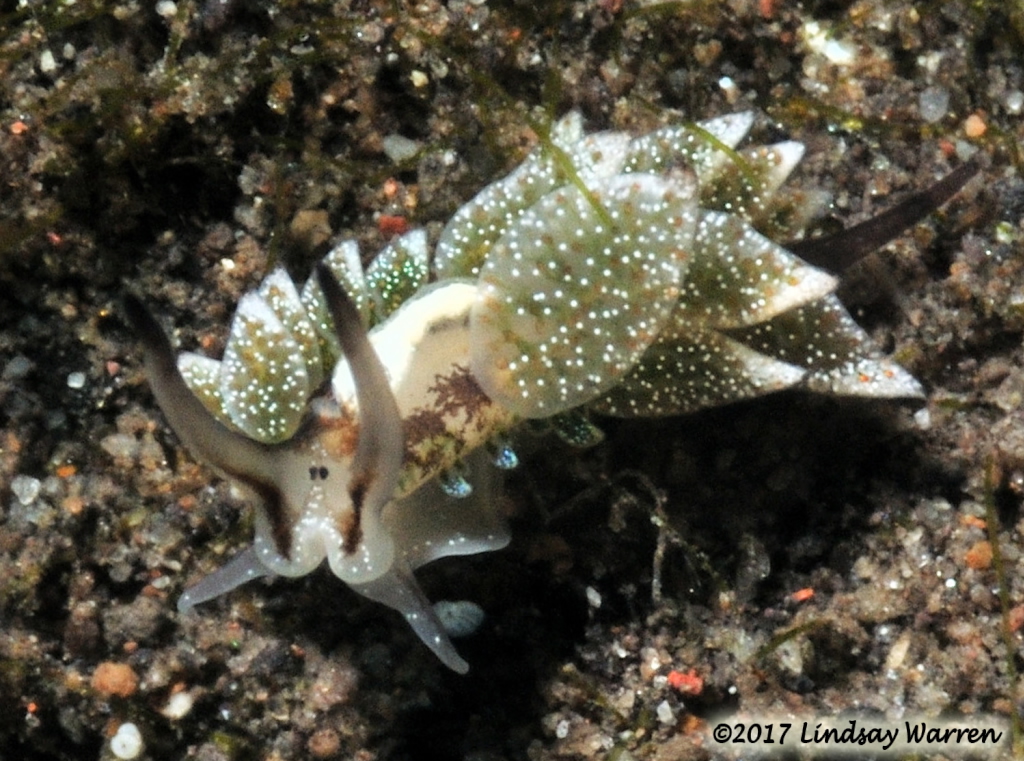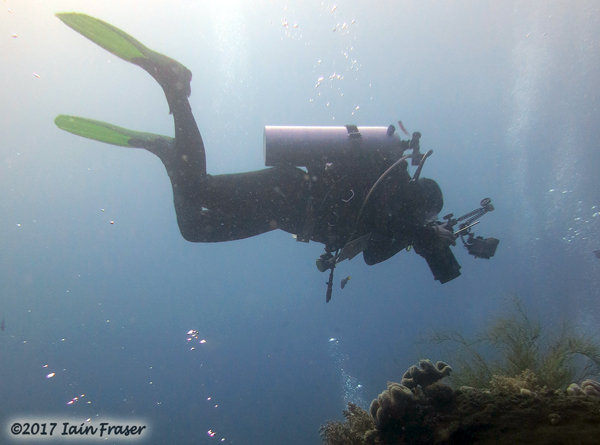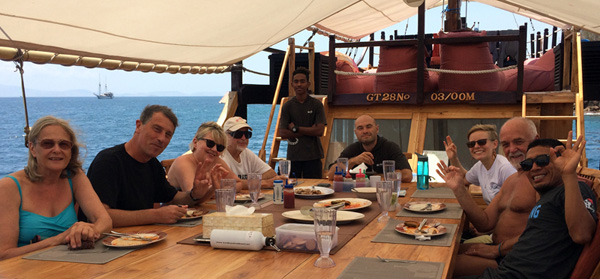 |
Costasiella formicaria
Image courtesy of Lindsay WarrenPulau Sangeang, Nusa Tenggara Timur, Indonesia
Photo taken using a Nikon D300s with a 105 mm lens in an Aquatica housing plus
a Macromate 2:1 wet diopter and with 1 x Inon Z-240 strobe
L: 4 mm, D: 18 m
Date: 17 September 2017
Photo Credit: Iain Fraser
 |
Costasiella formicaria(
Baba 1959) This tiny specimen of Costasiella formicaria (Baba, 1959), clearly not fully grown, was found moving along in the open on one of the volcanic sand slopes of Sangeang Island. The waters around this volcanically active island have proved to be a richly rewarding location for opisthobranchs. C. formicaria is overall translucent grey with small white spots along the anterior edge and along the foot margin; just behind the rhinophores is a long prominent white pericardial hump; the simple rhinophores feature a black stripe running down their posterior surface, black apices and a short black line on the anterior lower section. Of special note, and unlike other species of Costasiella, C. formicaria has very long anterior foot corners. The cerata are translucent pale grey through which one can see the digestive diverticula which extend from the main part of the body; also present are brown and green patches, and a generous sprinkling of bright white dots which are particularly numerous along the ceratal apices. Along the sides of its body beneath the larger cerata one can see small new cerata developing. As with other species of Costasiella the two eye spots are located close together between the rhinophores. Baba's original description of Stiliger formicarius (its original name) includes the following: "Rhinophores simple (with a trace of outer longitudinal groove near the base). Foot-corners unusually produced to form long-pointed tentacles. Fusiform branchial papillae arranged in 5-7 oblique rows on back-margins, each row containing from 3 to 4 papillae. Liver-diverticula ramified in the papillae. Pericardial prominence markedly elongate-oval, extending from behind the base of the rhinophores to about the middle of the back. Anus is situated at the right anterior corner of the pericardial prominence; nephroproct closely inside the anus... General body-colour black. Almost all of the specimens have a white patch on the top of the head, between the two rhinophores. Branchial papillae always tipped with white. Sole colourless. .... " The colour differences between the specimen in the photos and Baba's original description could be down to size and perhaps the coloration had not yet fully developed in the one in the photos. |
This was one of the many great finds photographed while diving with a small team of enthusiasts enjoying a week's trip on the Wunderpus, a small live-aboard which operates out of Labuanbajo, Flores. For this trip co-owner Chris Edison had been persuaded to spend most of the time around the actively volcanic island of Sangeang but also in Bima Bay, Sumbawa and then Komodo National Park.
Bali, Indonesia
Feb., 2018
Send Lindsay email at lwarren@datonomy.co.uk
(Mr Slug Site), co-owner Chris Edison, Bree Zabriski, Jim Anderson & Yan Alfian.
Photo by Iain Fraser, also a team member

As regulars to the Slug Site will already know from seeing her previous contributions, Lindsay's fascination with all things aquatic began as a small child and this has carried on throughout her life. However, it was only when at university that she discovered that diving was not just the prerogative of the elite. Beginning in 1974 with her first OW dive in 1975 near Marseilles, France, she noted in her logbook finding a nudibranch but had no idea what it was at the time. However many years later she was happily able to identify it. On the photographic front, the only reason she ever took it up was purely to document what she saw when diving. She started with a second-hand Nikonos II, then a Nikonos III and later progressed to a Nikon F3 in an Aquatica housing. However, she became an accomplished photographer of land & air wildlife as well as human life events, capturing special moments. And yet still her first love remains with molluscs. Having dived in many areas of the world including the UK, the Mediterranean, (Spain, France, Corsica), Red Sea (Israel & Egypt), Bahamas, USA (Florida, California, Hawaii), St Lucia, Montserrat, South Africa, Madagascar, Brazil, Fiji, Tonga, French Polynesia, the Tukang Besi Archipelago (SE Sulawesi, Indonesia), Lindsay now spends most of her time in Indonesia diving in places such as Bali, Alor, Lembeh as well as Sangeang, Komodo, Flores, Sumbawa, but also in the species rich Philippines. |
Lindsay was a prolific contributor to Bill Rudman's Sea Slug Forum when it was still an active site but she continues to look for and photograph opisthobranchs of all kinds sharing her finds with us via facebook, contributions to ebooks and id apps as well as direct with taxonomists around the world.
San Diego, Calif
Feb., 2018
Send Mike email at mdmiller@cts.com
